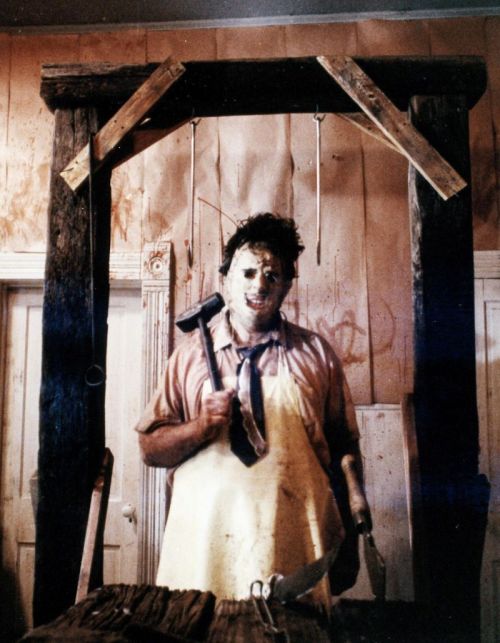
Pinhead — The diabolical creature known as Pinhead was once a human by the name of Elliot Spenser. A captain of the British Army, Spenser engaged in the Battle of Flanders. Watching the carnage around him made him realize just how cruel mankind can be, and he eventually lost his faith in all humanity and in God, saying “to us, God fell at Flanders, too”. Shaken by post-traumatic stress disorder from the events, Spenser turned to a hedonistic lifestyle to take the edge off.
Spenser eventually found himself turning to baser forms of pleasure as he made his travels. He soon learned of the Lament Configuration, a puzzle box created by a Frenchman by the name of Phillip Lemarchand. It was rumored that solving the puzzle would open a gateway into Hell. After much effort, Spenser finally acquired the box and promptly solved it. To his surprise, hooked chains shot out of the box and dragged him down to Hell.
Trapped inside one of Hell’s many chambers, Spenser was tortured in gruesome fashion. A grid-like pattern was slowly carved onto his head, forming hideous scars. At each intersection of the grid, large nails were driven into his flesh. Spenser somehow grew to associate the pain with pleasure, and eventually learned to enjoy his own torment.
Spenser then began to lose all memories of his life. Once his former identity was completely wiped out, his transformation into a Cenobite, a servant of the ruler of Hell, was complete. He soon became the executor of the Lament Configuration, emerging from the box once the puzzle was completed. He and his Cenobite cohorts then examine the boundaries between pain and pleasure by putting whoever opens the Lament Configuration through excruciating, seemingly-endless torture.

Jigsaw — John Kramer once made a living as a simple toy maker. He treated most aspects of his life with complacency, including his romantic relationships. His inability to make commitments eventually caused his girlfriend to leave him. However, even this didn’t help him realize the damage his indifference was doing to his life.
He had an epiphany, however, after one fateful hospital visit. He had been getting severely ill, often to the point of vomiting. He was later diagnosed with cancer and an inoperable brain tumor. Faced with his fast-approaching mortality, Kramer finally realized how much of his life he allowed himself to waste. While at the hospital, he became increasingly sensitive to people he perceived were wasting their lives as well. Heroin addicts and suicide attempters, in his opinion, failed to realize how precious life truly was.
Depressed with how futile he saw life was, Kramer decided to end it all and commit suicide. However, he survived the attempt, despite having driven his car over a cliff. Clinging on to the remaining bits of life he had made him realize just how valuable it is to be alive. Instead of ending his own life, Kramer vowed to help others take control and embrace their own lives.
Unfortunately, in Kramer’s own twisted perspective, that entailed bringing them to the brink of death. Just as he had his realization in the midst of anguish and looming death, so too, would his “subjects”. Kramer then spent the next few months following and observing people who he thought needed saving. He then fashioned cruel and sadistic puzzles that would “save” them by making them endure intense physical and mental torture. Kramer proceeded to abduct his subjects and force them into the specially-designed puzzles, in which they could only either escape with an increased appreciation for life, or die a horrible, agonizing death.
Most of Kramer’s subjects suffered the latter. At the end of each “experiment”, Kramer would cut off a small puzzle-shaped piece of flesh from the corpse, meant to represent the piece of humanity missing in the victim — the survival instinct. This odd modus operandi would later lead the authorities to dub Kramer the “Jigsaw Killer”.

Leatherface — Two men would come to be known as the chainsaw-wielding Leatherface. The first was Bubba Sawyer, a mentally-retarded man under the control of his twisted family. Raised by a group of deranged cannibals, Bubba did the Sawyers’ dirty work in killing the people who would eventually become his family’s chili. Bubba had no true personality, only acting through the different personas of his masks made from human faces. As such, Bubba was different from most other serial killers in that he killed primarily out of fear, or out of his family’s orders.
The second man to wear the many masks of Leatherface was Thomas Hewitt. Hewitt was often bullied as a child due to his muteness, mental retardation, and the facial disfigurement he suffered as a result of a flesh-eating disease. He was eventually diagnosed with mental degeneration at the young age of twelve.
Hewitt eventually tried to live a normal life, finding work in the very meat factory he was born in. Unfortunately, health inspectors order the factory to shut down, and Hewitt’s boss and co-worker urge him to leave. Hewitt’s refusal to follow orders leads the two to call him a “dumb animal” and a “retard”. The insults trigger Hewitt’s memory of the cruelty he suffered in his childhood, and the years of abuse cause him to finally snap. He grabs a sledgehammer and bludgeons the two to death. As he goes around the factory, he chances upon a chainsaw, which would eventually become his weapon of choice. The murder is then discovered by local sheriff Winston Hoyt, who tries to stop Hewitt. Hewitt is saved, however, by his uncle, Charlie Hewitt, who kills Hoyt and assumes his identity.
The abusive Charlie takes advantage of Hewitt’s mental retardation and manipulates him into doing his twisted work. Hewitt becomes the family’s most prominent murderer, supplying them with the human flesh needed to supply their meat shop. Hewitt, sick of the ridicule he’s received because of his hideous appearance, eventually makes a mask by slicing off the face of one of his victims, creating Leatherface as we know and fear him.

Norman Bates — No other killer is a more popular cautionary tale than Norman Bates. Undergoing severe emotional (and implied sexual) abuse from his mother as a child, Bates’ mental state had become incredibly fragile. Things worsened when Bates’ father died, leaving mother and son to fend for themselves. Bates’ mother constantly warned him about the evils of sex, and told him that all women — save for her — were whores. This cycle of abuse and the demonization of all other women created an unhealthy co-dependence between the two.
That co-dependence was challenged when Bates’ mother suddenly took in a lover. Feeling abandoned by the only other person he felt safe with, Bates extracted his vengeance by poisoning both his mother and her lover with strychnine. Both horrified with what he had done and obsessed with his mother, Bates then took to preserving her body and acting as though she were still alive. In order to preserve his rapidly-crumbling psyche, Bates maintained the illusion of having a mother by developing a separate personality — “Norma” Bates. Bates would then go on to manage the family motel as both Norman and Norma.
His mother’s influence would never leave him, and Bates would continue to perceive women as “evil” and “dirty”. Whenever the “Norman” persona would become infatuated with ladies staying at the motel, the “Norma” persona would take over, leading Bates to dress up in his deceased mother’s clothing and murder the women. He would speak in his mother’s voice and scold himself (“Norman”) for forgetting that women were filthy whores, and that “mother” was the only one who mattered. Eventually, Bates’ fragile psyche would eventually break down, and the murderous “mother” would completely take over.
(Via A lucky place to be)

2 comentarios:
Esta peña es de cuidao, mis favoritos los dos primeros ^^
Saludos!!!
Mi favorito es Leatherface de toda la vida ¡¡¡¡¡
Publicar un comentario